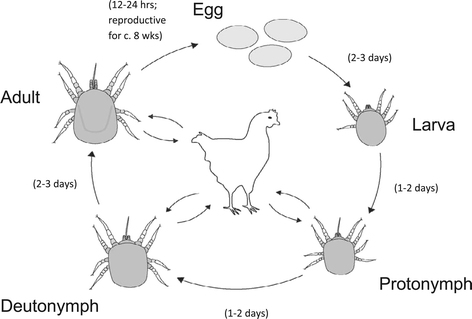Should the poultry red mite Dermanyssus gallinae be of wider concern for veterinary and medical science?
- PMID: 25884317
- PMCID: PMC4377040
- DOI: 10.1186/s13071-015-0768-7
Should the poultry red mite Dermanyssus gallinae be of wider concern for veterinary and medical science?
Abstract
The poultry red mite Dermanyssus gallinae is best known as a threat to the laying-hen industry; adversely affecting production and hen health and welfare throughout the globe, both directly and through its role as a disease vector. Nevertheless, D. gallinae is being increasingly implemented in dermatological complaints in non-avian hosts, suggesting that its significance may extend beyond poultry. The main objective of the current work was to review the potential of D. gallinae as a wider veterinary and medical threat. Results demonstrated that, as an avian mite, D. gallinae is unsurprisingly an occasional pest of pet birds. However, research also supports that these mites will feed from a range of other animals including: cats, dogs, rodents, rabbits, horses and man. We conclude that although reported cases of D. gallinae infesting mammals are relatively rare, when coupled with the reported genetic plasticity of this species and evidence of permanent infestations on non-avian hosts, potential for host-expansion may exist. The impact of, and mechanisms and risk factors for such expansion are discussed, and suggestions for further work made. Given the potential severity of any level of host-expansion in D. gallinae, we conclude that further research should be urgently conducted to confirm the full extent of the threat posed by D. gallinae to (non-avian) veterinary and medical sectors.
Figures



References
-
- Agosta SJ, Janz N, Brooks DR. How specialists can be generalists: resolving the “parasite paradox” and implications for emerging infectious disease. Zoologia-Curitiba. 2010;27:151–162.
-
- Kiewra D, Lonc E. Epidemiological consequences of host specificity of ticks (Ixodida) Ann Parasitol. 2012;58:181–187. - PubMed
-
- Sparagano O, George DR, Harrington D, Giangaspero A. Biology, epidemiology, management and risk related to the poultry red mite, Dermanyssus gallinae. Annu Rev Entomol. 2014;59:447–466. - PubMed
-
- Roy L, Chauve CM. Historical review of the genus Dermanyssus Duges, 1834 (Acari: Mesostigmata: Dermanyssidae) Parasite. 2007;14:87–100. - PubMed
Publication types
MeSH terms
LinkOut - more resources
Full Text Sources
Other Literature Sources
Miscellaneous

